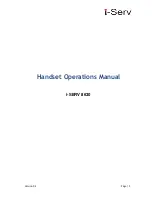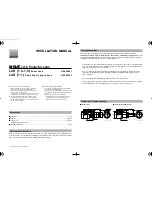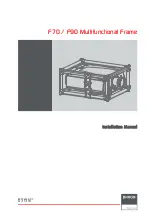
MIO Console Overview
164
Routing is critical!
It is very important to understand that
the v.5 mixer does not provide default routings!
You must choose where you want your audio to go. If you don’t route a mix bus to a physical output, you
will not hear any audio. If you don’t route an input to FireWire it will not be available to any applications
in your computer.
Routing in v.5 is really easy — so just remember — if you are not hearing or seeing your audio where
you expect to, check your routings!
A Quick Tour of the v. 5 Mixer
The v.5 mixer provides the following functions:
•
Many channels per interface.
• All interfaces support 18 channels to/from the computer over FireWire at 44.1-96kHz sample rates
• ULN-8 and LIO-8 support 8 channels to/from the computer over FireWire at 176.4-192kHz sample
rates
• You may connect up to 3 interfaces per FireWire bus at 44.1-96kHz rates or 2 interfaces at
176.4-192kHz rates. For more information please refer to the appendix on
FireWire
.
•
Multiple mix busses (limited only by DSP resources) with up to 48 inputs per bus.
• Each bus supports a configurable width (mono to 7.1 surround)
• Each bus provides full metering
• Any bus may be used as an input source for any other bus
•
Any number of channel strips, up to 48 per mix bus.
• Each channel strip may be fed by any available source in the system (including physical I/O, FireWire,
DAW returns, or busses in the system.
• Channel strips for physical I/O provide direct access to any available I/O controls (like phantom power
or input trim).
• Each channel strip provides a phase invert button.
• Each channel strip offers our unique Character processing control.
• Each channel strip provides a pre-insert Direct Out routing point to route the channel strip to any
Physical Output or FireWire Return. This may be used for recording dry signals and/or routing the
MIO as a stand-alone A/D converter.
• Each channel strip provides ten (10) Plug-in insert slots.
• Each channel strip provides a post-insert Direct Out routing point to route the channel strip to any
Physical Output or FireWire Return. This may be used for recording wet signals and/or routing signals
through the MIO to use it as a signal processor.
• Each mono channel strip provides a panner appropriate for the kind of bus it is feeding. For strips
feeding mono busses, there is no panner; for strips feeding stereo and LCR buses, a knob panner is
used; for strips feeding an LCRS bus and beyond, a surround panner is used.
Multichannel input strips do not provide panners; they feed directly into the bus, and panning must
be done at the source feeding the input.
• Each channel strip provides a record-enable button that is linked to the record panel.
• Each channel strip provides a mute button, solo button, and level fader.
• Each channel strip provides a meter that reflects the input level to the mixer.
• Each channel strip provides a bus-assign routing control to select which mix bus (or busses) will be
fed by the channel strip.
Содержание +DSP
Страница 1: ...Mo b i l e I O U s e r s G u i d e...
Страница 17: ...Mobile I O Users Guide 17 321 Phase Cancellation 362...
Страница 21: ...Part I Quick Start Guides...
Страница 53: ...Part II Interfaces...
Страница 127: ...Part III Software...
Страница 132: ...Software 132 Band Split 314...
Страница 229: ...Routing Examples 229 Figure 13 45 Output Tab Create 16 mono outputs and map them to DAW 1 16 in MIO Console...
Страница 315: ...Part IV Appendices...
Страница 317: ...Appendices 317 J Support Resources 351 K Changelog 352...
















































